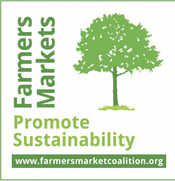Farmers Markets Promote Sustainability
 Farmers Markets Promote Sustainability
Farmers Markets Promote Sustainability
Behind the rows of produce, busy vendors, and eager customers, farmers markets are a bustling hub of sustainability. Local farmers deliver fresh, local food to a growing number of shoppers demanding food that is not only healthy, but environmentally friendly. But farmers markets take sustainability a step further. They also ensure farmers can make a living off sustainably grown food, while providing an outlet where communities can find and purchase their products.
Sustainability is the overarching theme in this system. Farmers engage in sustainable farming practices to produce healthy food to sustain the local community, who in turn provide the money necessary to sustain the farmers. Each shares in the success of the other in a mutually beneficial relationship that has become a model for sustainability.
Farmers who choose to use sustainable practices face a challenging economic climate dominated by large, corporate farms. Many find they cannot compete with the massive volume, low market prices, and government subsidies enjoyed by large operations. Farmers markets offer small and mid-sized farmers a low-barrier entry point to develop and establish a thriving business free from the overhead necessary to sell in large retail outlets. But just as important, farmers markets create a space where the focus of food is on quality and farming practices rather than price alone.
Each year, more and more customers are drawn to farmers markets due to an increasing demand for natural and organic food. According to a USDA survey, markets that sell organic products report more customers per week, more vendors, and larger monthly sales. This upward trend depicts a rising consciousness among customers who are concerned with not just what they eat, but how it is produced. As a result, more and more farmers are adopting environmentally sound farming practices that improve, rather than degrade, the natural environment.
Farmers selling at markets minimize the amount of waste and pollution they create. Many use certified organic practices, reducing the amount of synthetic pesticides and chemicals that pollute our soil and water. A growing number are also adopting other low-impact practices, such as on-site composting, that help mitigate climate change and other environmental issues.
- Nearly half of markets sell organically labeled products, and many more sell chemical or pesticide-free labeled products. [i]
- A Vermont Price Study found that of the items compared, prices for many conventional products and all organic products, with the exception of potatoes, were lower at the farmers market than at nearby supermarkets. [ii]
- On average, food travels over 1,000 miles from the point of production to the retail store.[iii] In contrast, many farmers markets only allow vendors to sell food produced within 200 miles. Some markets only have food grown within 50 miles.
- Locally or regionally sourced produce travels about 27 times less distance than conventionally sourced produce.[iv]
- In a 2015 survey of farmers selling at farmers markets:[v]
- One in four farmers selling at farmers markets cultivate land that is protected from commercial development.
- Three out of every four say they use practices consistent with organic standards.
- 48% use integrated pest management, information on the life cycle of pests and their interaction with the environment to manage and prevent crop damage.
- 81% incorporate cover crops, reduced tillage, on-site composting, and other soil health practices into their operations.
- Four out of five discuss farming practices with their customers, educating them about farming and its interactions with the natural environment.
- 69% sell vegetables, 53% livestock, poultry or eggs, 47% fruits and tree nuts, and 31% value-added products. There is tremendous diversity in the foods and farm products being sold at farmers markets.
